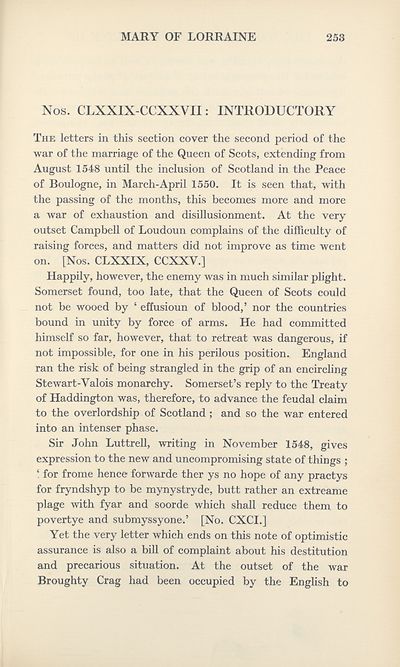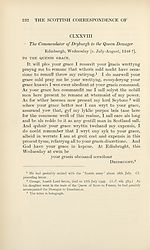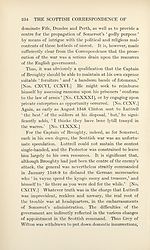Series 3 > Scottish correspondence of Mary of Lorraine
(286) Page 253
Download files
Complete book:
Individual page:
Thumbnail gallery: Grid view | List view

MARY OF LORRAINE
253
Nos. CLXXIX-CCXXVII: INTRODUCTORY
The letters in this section cover the second period of the
war of the marriage of the Queen of Scots, extending from
August 1548 until the inclusion of Scotland in the Peace
of Boulogne, in March-April 1550. It is seen that, with
the passing of the months, this becomes more and more
a war of exhaustion and disillusionment. At the very
outset Campbell of Loudoun complains of the difficulty of
raising forces, and matters did not improve as time went
on. [Nos. CLXXIX, CCXXV.]
Happily, however, the enemy was in much similar plight.
Somerset found, too late, that the Queen of Scots could
not be wooed by ‘ effusioun of blood,’ nor the countries
bound in unity by force of arms. He had committed
himself so far, however, that to retreat was dangerous, if
not impossible, for one in his perilous position. England
ran the risk of being strangled in the grip of an encircling
Stewart-Valois monarchy. Somerset’s reply to the Treaty
of Haddington was, therefore, to advance the feudal claim
to the overlordship of Scotland ; and so the war entered
into an intenser phase.
Sir John Luttrell, writing in November 1548, gives
expression to the new and uncompromising state of things ;
‘ for frome hence forwarde ther ys no hope of any practys
for fryndshyp to be mynystryde, butt rather an extreame
plage with fyar and soorde which shall reduce them to
povertye and submyssyone.’ [No. CXCL]
Yet the very letter which ends on this note of optimistic
assurance is also a bill of complaint about his destitution
and precarious situation. At the outset of the war
Broughty Crag had been occupied by the English to
253
Nos. CLXXIX-CCXXVII: INTRODUCTORY
The letters in this section cover the second period of the
war of the marriage of the Queen of Scots, extending from
August 1548 until the inclusion of Scotland in the Peace
of Boulogne, in March-April 1550. It is seen that, with
the passing of the months, this becomes more and more
a war of exhaustion and disillusionment. At the very
outset Campbell of Loudoun complains of the difficulty of
raising forces, and matters did not improve as time went
on. [Nos. CLXXIX, CCXXV.]
Happily, however, the enemy was in much similar plight.
Somerset found, too late, that the Queen of Scots could
not be wooed by ‘ effusioun of blood,’ nor the countries
bound in unity by force of arms. He had committed
himself so far, however, that to retreat was dangerous, if
not impossible, for one in his perilous position. England
ran the risk of being strangled in the grip of an encircling
Stewart-Valois monarchy. Somerset’s reply to the Treaty
of Haddington was, therefore, to advance the feudal claim
to the overlordship of Scotland ; and so the war entered
into an intenser phase.
Sir John Luttrell, writing in November 1548, gives
expression to the new and uncompromising state of things ;
‘ for frome hence forwarde ther ys no hope of any practys
for fryndshyp to be mynystryde, butt rather an extreame
plage with fyar and soorde which shall reduce them to
povertye and submyssyone.’ [No. CXCL]
Yet the very letter which ends on this note of optimistic
assurance is also a bill of complaint about his destitution
and precarious situation. At the outset of the war
Broughty Crag had been occupied by the English to
Set display mode to:
![]() Universal Viewer |
Universal Viewer | ![]() Mirador |
Large image | Transcription
Mirador |
Large image | Transcription
Images and transcriptions on this page, including medium image downloads, may be used under the Creative Commons Attribution 4.0 International Licence unless otherwise stated. ![]()
| Scottish History Society volumes > Series 3 > Scottish correspondence of Mary of Lorraine > (286) Page 253 |
|---|
| Permanent URL | https://digital.nls.uk/126737055 |
|---|
| Attribution and copyright: |
|
|---|
| Description | Over 180 volumes, published by the Scottish History Society, containing original sources on Scotland's history and people. With a wide range of subjects, the books collectively cover all periods from the 12th to 20th centuries, and reflect changing trends in Scottish history. Sources are accompanied by scholarly interpretation, references and bibliographies. Volumes are usually published annually, and more digitised volumes will be added as they become available. |
|---|


